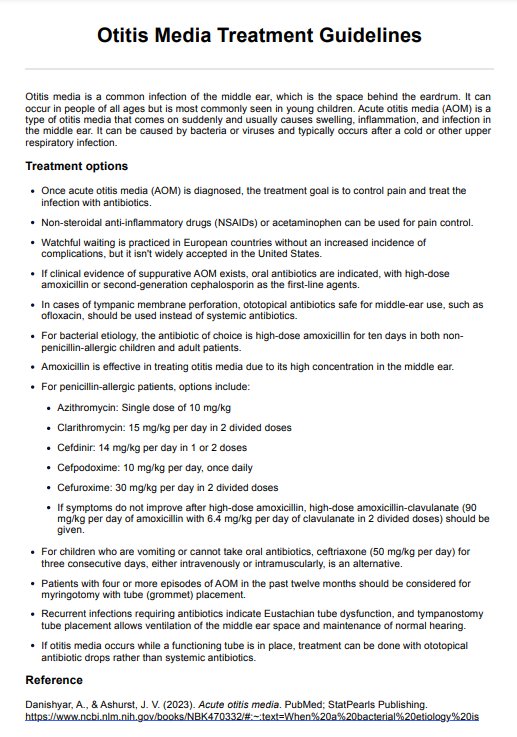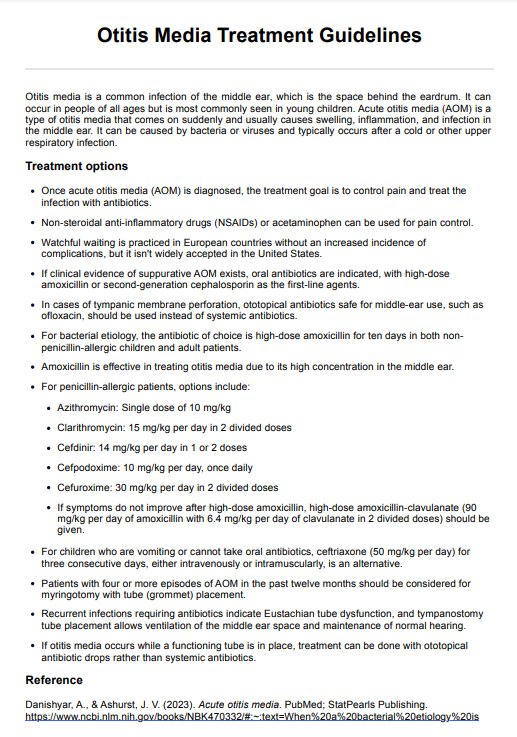Otitis Media Treatment Guidelines
Discover guidelines for treating otitis media, including symptoms, causes, and effective treatments. Download our free PDF and learn how to manage middle ear infections.


What is otitis media?
Otitis media refers to inflammation or infection of the middle ear. It is a common condition that predominantly affects children but can also occur in adults. The inflammation typically results from a bacterial or viral infection that causes fluid to build up behind the eardrum, leading to discomfort and potential hearing issues. Knowing what otitis media is and how to manage it is crucial for healthcare professionals, ENT specialists, and pediatricians to provide effective treatment.
Otitis media symptoms
The symptoms of otitis media can vary based on the type and severity of the infection. Common symptoms of this ear infection include:
- Ear pain, often severe
- A feeling of fullness in the ear
- Hearing difficulties
- Fluid drainage from the ear
- Fever
- Irritability and restlessness in children
- Loss of appetite
- Trouble sleeping
Causes of otitis media
Several factors can lead to the development of otitis media, including:
- Bacterial or viral infections: Infections in the respiratory tract can spread to the middle ear.
- Allergies: Allergic reactions can cause swelling and fluid buildup in the middle ear.
- Eustachian tube dysfunction: Blockage or dysfunction of the Eustachian tube can lead to fluid retention in the middle ear.
- Environmental factors: Exposure to smoke or pollution can increase the risk of infections.
- Anatomical factors: Children have shorter and more horizontal Eustachian tubes, causing frequent ear infections.
Otitis Media Treatment Guidelines Template
Otitis Media Treatment Guidelines Example
10 otitis media treatments
Treating acute otitis media in clinical practice requires addressing symptoms, eradicating infections, and preventing complications in one or both ears. Some treatments for otitis media include:
1. Watchful waiting
Observation is recommended for mild cases of middle ear infection, particularly in pediatric patients, to determine if symptoms resolve spontaneously within 48 to 72 hours. This approach minimizes unnecessary antibiotic treatment.
2. Pain management
Administer over-the-counter analgesics such as acetaminophen or ibuprofen to alleviate discomfort and reduce fever. Warm compresses may also provide symptomatic relief for ear pain.
3. Antibiotic therapy
Antibiotics such as amoxicillin are prescribed when a bacterial infection is confirmed, or symptoms of persistent acute otitis media (AOM) persist. Ensure patients complete the full course to prevent recurrent otitis media and resistance.
4. Myringotomy
For severe or recurrent middle ear infections, consider myringotomy. This minor surgical procedure involves making a small incision in the tympanic membrane to drain the middle ear fluid and relieve pressure.
5. Tympanostomy tubes
Tympanostomy tubes should be inserted in chronic suppurative otitis media or middle ear effusion to facilitate fluid drainage and prevent future infections.
6. Antihistamines and decongestants
While not routinely recommended for children, these medications can reduce nasal congestion and Eustachian tube dysfunction, potentially beneficial in select adult patients.
7. Prevention strategies
Implement preventive measures such as promoting regular handwashing, avoiding exposure to smoke, and ensuring up-to-date vaccinations such as influenza and pneumococcal vaccines.
8. Home remedies
Advise patients to elevate the head during sleep or use a humidifier to maintain air moisture, which can provide relief within the middle ear space.
9. Ear drops
Utilize over-the-counter or prescription ear drops to manage and relieve pain and middle ear inflammation.
10. Allergy management
Appropriate medications or lifestyle modifications should be recommended for patients with underlying allergies to reduce the incidence of middle ear infections.
Otitis media, including middle ear disease and chronic suppurative otitis media, is prevalent in children and adults. While most cases resolve with conservative treatments, recurrent acute otitis media necessitates professional medical care.
How to use our Otitis Media Treatment Guidelines template
Here's how to use our template:
Step 1: Download the handout
Get a copy of the Otitis Media Treatment Guidelines using the link on this page or via the Carepatron app. It's also available in our resources library.
Step 2: Review the guidelines
Take some time to read through the guidelines to familiarize yourself with the topic. You may also want to bookmark any sections that you may need to refer back to later.
Step 3: Follow the recommendations
Based on your patient's condition and individual factors, follow the recommendations outlined in the guidelines for treatment of acute otitis media. Take note of any specific dosages or administration instructions.
Step 4: Monitor patient progress
After implementing the recommended treatment plan, it is important to closely monitor your patient's progress and make adjustments as needed. If there are any concerns or complications, refer back to the guidelines for guidance.
Step 5: Communicate with the patient and their caregivers
It's important to keep open communication with your patient and their caregivers throughout the treatment process. Make sure they understand the treatment plan and any potential side effects or warning signs to look out for.
How this handout may benefit ENTs
Providing ENTs with a structured treatment guideline for otitis media can significantly enhance patient care by:
- Standardizing treatment protocols and ensuring consistency.
- Reducing the likelihood of inappropriate treatment.
- Enhancing communication between healthcare providers and patients' families.
- Offering a quick reference guide for common and complex cases.
ENT specialists can improve patient outcomes by focusing on a well-rounded approach integrating prevention, treatment, and education. We encourage all healthcare providers to utilize these resources to stay informed and deliver the highest quality of care possible for recurrent infections.
Commonly asked questions
Acute otitis media is an infection of the middle ear characterized by rapid onset of symptoms like ear pain and fever, whereas otitis media with effusion involves fluid accumulation in the middle ear without signs of infection.
Antibiotics are recommended for severe cases, children under six months, or when symptoms persist beyond 48 to 72 hours without improvement.
Potential complications include hearing loss, speech delays in children, and the spread of infection to nearby structures.

.jpg)





































































































